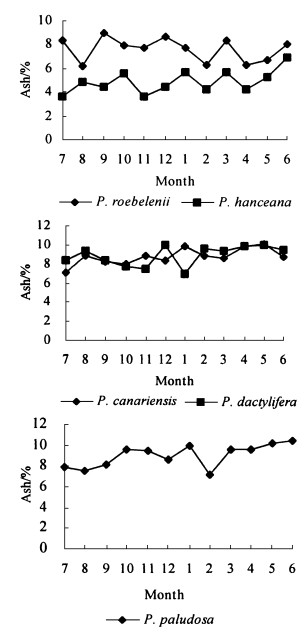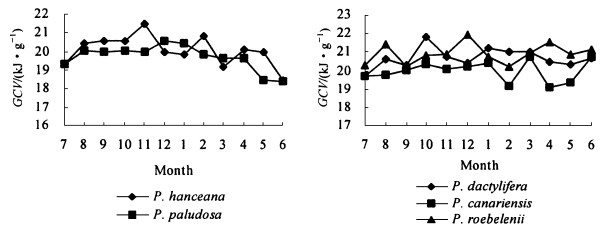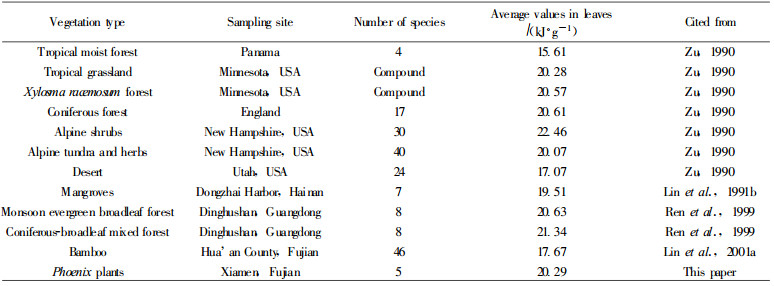文章信息
- Lin Yiming, Tan Zhongqi, Ding Yinlong, Lin Peng, Ye Gongfu
- 林益明, 谭忠奇, 丁印龙, 林鹏, 叶功富
- MONTHLY CHANGES IN THE CALORIC VALUES AND ASH CONTENTS OF FIVE PHOENIX SPECIES IN PALMAE
- 棕榈科刺葵属5种植物热值的月变化研究
- Scientia Silvae Sinicae, 2003, 39(专刊1): 62-67.
- 林业科学, 2003, 39(专刊1): 62-67.
-
文章历史
Received date: 2003-03-21
-
作者相关文章
2. 厦门市园林植物园 厦门 361003;
3. 福建省林业科学研究院 福州 350012
2. Botanical Garden of Xiamen Xiamen 361003;
3. Fujian Academy of Forestry Fuzhou 350012
The measurement of caloric values is one of the most important ways in ecology research. Sun et al. (1993)pointed out that the most importance of the measurement of caloric value is that it can reflect the changes of physiological activity and plant growth, and the variation in caloric equivalents for plants was a possible response to environment; Caloric value was an evaluation index of plant growth.So far, relevant researches in the energy characteristics of forest ecosystems at home and abroad mainly include:biomass and energy production, energy flow and energy conversion efficiency (Srivastava, 1995; Lin et al., 1996; Lin, 1999); dynamics of caloric values and ecological adaptations (Lin et al., 2002; 2003).
In this study, analyses were completed to determine the monthly changes in caloric values of five Phoenix species in Palmae in Xiamen City. Palmae is a rare family in Monocotyledoneae of tree-dwelling, broad-sclerophyll and developed vascular system, mainly distributed in tropical (Ma, 1998).Because of abundant species and flourishing habit and characteristic, Palmae species are mainly used to plant in southern cities of China. Therefore, we selected Phoenix species of Palmae, to determine the monthly changes of ash contents, gross caloric values and ash-free caloric values in the leaves to recognize the ecological adaptability of plants, in purpose to provide the theoretical support for protection, development and management of the Palmae plants.
1 Materials and MethodsThe research was carried out at Xiamen Botanical Garden. The climate is southern subtropical monsoon, with an average annual temperature of 21.1℃, an average annual precipitation of 1 036mm, and a relative humidity of 80%.The soil under Palmae plants is sandy earth, with 2 cm thick organic litter matter layer at the surface. The selected 5 Phoenix species were P. hanceana, P. paludosa, P. roebelenii, P. dactylifera, and P. canariensis.
The leaf materials used in the caloric determinations were collected at the end of every month from July 2000 to June 2001;all sample collection and work procedures were described in detail by Lin et al. (2003).The monthly mean air temperature and rainfall were shown in Tab. 1.
|
|
All the leaf samples were dried at 80 ℃, milled to pass through a 40-mesh sieve, and then stored in a desiccator until analysis. The caloric value per gram dry weight (referred to below as gross caloric value, GCV)was determined by burning samples in a GR-3500 Oxygen Bomb Calorimeter at 20℃.At least two measurements were made per sample (Yang, 1982); the ash content was determined by the ashing method (550 ℃, 5 h).Caloric value per gram ash-free dry weight (referred to below as ash-free caloric value, AFCV)was calculated as AFCV=GCV (1-Ash%).
The coefficient of variation between replicates was less than 2% for gross caloric value and ash content.
2 Results and Discussion 2.1 Ash contentAsh content is the total of ash elements; it varies among plant species and during plant development (Lin et al., 2001b).P. roebelenii had the same seasonal trends as P. hanceana(Fig. 1), and the range of P. roebelenii (6.20% ~ 8.93%)was significantly higher than P. hanceana (3.59% ~ 6.94%)(P < 0.000 1).

|
Fig.1 Monthly changes in the ash contents of five Phoenix species from July 2000 to June 2001 |
P. canariensis had the same seasonal trends as P. dactylifera. The range of P. paludosa(7.25% ~ 10.39%), P. canariensis(7.12% ~ 10.09%) and P. dactylifera(7.01% ~ 10.00%)was similar, and the differences were not significant by t test(P > 0.05).P. canariensis, P. dactylifera and P. paludosa had higher ash contents than P. roebelenii (P < 0.05) and P. hanceana(P < 0.000 1).
Compared with the other plants in tropical and subtropical zones, the ash contents of seven mangrove species at Dongzhai harbor in Hainan ranged from 7.11% to 9.80% (Lin et al., 1991b), those of monsoon evergreen broad-leaf forest from 2.6% to 5.2%, 1.5% to 3.8% for coniferous and broad-leaf mixed forest, 1.9% to 3.8% for coniferous forest (Ren et al., 1999).Five Phoenix plants (3.59% ~ 10.39%)had the relatively high ash contents in the leaves similar to mangrove plants.The ash contents were related with the amounts of nutrient elements absorbed in plant body, which can index the role of element enrichment of plants.For example, Avicennia marina(a mangrove plant)leaves are used as green manure in Guangxi because the leaves are rich in ash content (12.27%), especially in N, P (Lin, 1984).Element enrichment levels in plant components depend on their respective need for elements, and related with element contents and existing patterns in soils.However, existing patterns of elements were influenced by various factors so that ash contents are no constants related to the soil conditions for plant growth and the values can reflect the character of selective absorption and accumulation on nutrient elements by different plants.
2.2 Gross caloric valueAs shown in Fig. 2, there were some differences in the monthly changes of the gross caloric values for these five species, and P. hanceana and P. paludosa had the similar trends, different from the other species.

|
Fig.2 Monthly changes in the gross caloric values of five Phoenix species from July 2000 to June 2001 |
The range of P. roebelenii (20.24 ~ 21.93 kJ·g-1)was close to P. dactylifera (19.68 ~ 21.82 kJ·g-1), the differences were not significant by t test(P > 0.05);The range of P. hanceana(18.51 ~ 21.51 kJ·g-1), P. paludosa(18.40 ~ 20.56 kJ·g-1) and P. canariensis(19.13~ 20.79 kJ·g-1)was similar, the differences were not significant by t test(P > 0.05);P. roebelenii and P. dactylifera had the higher gross caloric values than P. hanceana(P < 0.05), P. canariensis(P < 0.005) and P. paludosa(P < 0.000 5).
Seasonal changes in the gross caloric values varied with the species (Tab. 2).The highest was in autumn for P. canariensis, P. hanceana and P. dactylifera, and the highest in winter for P. roebelenii and P. paludosa, respectively. Such fluctuations may be attributable to modification of tree vigor and nutritive condition resulting from rapid changes in environmental conditions.
|
|
Seasonal changes in gross caloric values have been demonstrated for forest trees together with a number of other ecosystem components (Golley, 1961; Madgwick, 1970; Hughes, 1971).Morrison (1949)reported that in many plants the percentage of crude protein in the green foliage decreased, that of crude fibre and nitrogen-free extract (mainly carbohydrates)increased, and that of ether extract (partly fat)remained constant through the growing season, accordingly, the gross caloric values of foliage should be higher in the spring than in the fall (Hughes, 1971).This was not apparently the case for Kandelia candel leaves (Lin et al., 1991a) and Rhizophora stylosa leaves (Yin et al., 1993).More data are required to firmly establish the general trends.
Seasonal changes in gross caloric values were correlated with phenology of plants and their reaction to environmental factors (Wielgolaski et al., 1975).The seasonal changes in the gross caloric values of these Phoenix species in Palmae supported this viewpoint.
Compared with other vegetation types (Tab. 3), average gross caloric values of 5 Phoenix species in Palmae (20.29 kJ·g-1)were lower than those of coniferous-broadleaf mixed forest(21.34 kJ·g-1) and monsoon evergreen broadleaf forest (20.63 kJ·g-1), higher than those of mangroves (19.51 kJ·g-1), bamboos (17.67 kJ·g-1) and tropical moist forest (15.61 kJ·g-1).
|
|
The differences in gross caloric values among various components were mainly influenced by the differences in their compositions (i. e.protein, lipid, carbohydrate, etc.), light intensity, length of day, soil types and the ages of plants (Golley, 1961; Madgwick, 1970; Hughes, 1971; Wahi, 1980; Lin et al., 1996).
In this study, Gross caloric values (y)were correlated remarkably with ash contents (x)for P. hanceana, but there was no significant correlation between gross caloric values and ash contents for other species (Tab. 4).
|
|
From Tab. 5, we could find that gross caloric values were correlated with monthly rainfall (P < 0.05)for P. hanceana, P. paludosa and P. dactylifera, respectively.
|
|
As far as ash-free caloric values are concerned, the range of P. dactylifera(21.47 ~ 23.63 kJ·g-1)was close to P. roebelenii(22.11 ~ 24.01 kJ·g-1), and the differenceswere not significant by t test(P > 0.05);The range of P. canariensis(21.04~ 22.75 kJ·g-1)was close to P. paludosa(20.54 ~ 22.71kJ·g-1), and the differences were not significant by t test(P > 0.05);The range of P. paludosa was higher than P. hanceana(19.89 ~ 22.43 kJ·g-1), and the differences were significant by t test (P < 0.05);Namely, P. dactylifera ≈P. roebelenii >P. canariensis ≈P. paludosa P. hanceana.
Seasonal ash-free caloric values varied with species (Fig. 3), the highest in autumn for P. canariensis and P. hanceana, the highest in winter for other species, respectively (Tab. 6).Seasonal changes in ash-free caloric values were different from that in gross caloric values resulted from the differences in ash contents.

|
Fig.3 Monthly changes in the ash-free caloric values of five Phoenix species from July 2000 to June 2001 |
|
|
Compared with other vegetation types, average ash-free caloric values of 5 Phoenix species in Palmae (22.02 kJ·g-1) were lower than those of coniferous-broadleaf mixed forest (22.43kJ·g-1), and higher than those of bamboos (20.85kJ·g-1).
3 ConclusionsFive Phoenix species had the relatively high ash contents and different monthly change trends.
Seasonal changes in the gross caloric values varied with the species, and P. hanceana and P. paludosa had the similar trends, different from other species; Such fluctuations may be attributable to modification of tree vigor and nutritive condition resulting from rapid changes in environmental conditions.
Gross caloric values were correlated remarkably with ash contents for P. hanceana, but there was no significant correlation between gross caloric values and ash contents for other species.
Gross caloric values were correlated with monthly rainfall (P < 0.05)for P. hanceana, P. paludosa and P. dactylifera, respectively.
Seasonal ash-free caloric values varied with species.Seasonal changes in ash-free caloric values were different from those in gross caloric values resulted from the differences in ash contents.
Golley F B. 1961. Energy values of ecological materials. Ecology, 42(3): 581-584. DOI:10.2307/1932247 |
Gupta S K. 1972. Energy structure of standing crop in certain grasslands at Gyanpur. Trop Ecol, 13: 147-155. |
Hughes M K. 1971. Seasonal calorific values from a deciduous woodland in England. Ecology, 52: 923-926. DOI:10.2307/1936045 |
Jordan C F. 1971. Productivity of a tropical forest and its relation to a world pattern of energy storage. J Ecol, 59: 127-142. DOI:10.2307/2258457 |
Lin G H(林光辉), Lin P(林鹏).The changes of caloric value of a mangrove species Kandelia candel in China. Acta Ecologica Sinica(生态学报), 1991a, 11(1): 44-48 http://en.cnki.com.cn/Article_en/CJFDTOTAL-STXB199101007.htm
|
Lin P(林鹏).Mangrove vegetation.Beijing: China Ocean Press(海洋出版社), 1984: 38-48
|
Lin P(林鹏).Mangrove Ecosystem in China.Science Press, Beijing, New York, 1999
|
Lin P(林鹏), Lin G H(林光辉).Study on the caloric value and ash content of some mangrove species in China.Acta Phytoecologica et Geobotanica Sinica(植物生态学与地植物学学报), 1991b, 15(2): 114-120 http://en.cnki.com.cn/Article_en/CJFDTOTAL-ZWSB199102001.htm
|
Lin Y M(林益明), Ke L N(柯莉娜), Wang Z C(王湛昌)et al.Seasonal changes in the caloric values of the leaves of seven mangrove species at Futian, Shenzhen.Acta Oceanologica Sinica(海洋学报), 2002, 24(3): 112-118 http://www.cnki.com.cn/Article/CJFDTotal-SEAC200203014.htm
|
Lin Y M(林益明), Lin P(林鹏), Li Z J(李振基)et al. Study on energy of Castanopsis eyrei community in Wuyi Mountains of Fujian province.Acta Bot Sin(植物学报), 1996, 38(12): 989-994 http://en.cnki.com.cn/Article_en/CJFDTOTAL-ZWXB199612010.htm
|
Lin YM(林益明), Li Z B(黎中宝), Chen Y Y(陈奕源)et al.Caloric values in leaves of some bamboo species in the Bamboo Garden of Hua' an county.Chinese Bulletin of Botany(植物学通报), 2001a, 18(3): 356-362
|
Lin YM(林益明), Wang Z C(王湛昌), Ke L N(柯莉娜)et al.Monthly changes in the caloric values of the leaves of four shrubby and four tree-dwelling Palmae species.Acta Ecologica Sinica(生态学报), 2003, 23(6): 1117-1124
|
Lin YM(林益明), Yang Z W(杨志伟), Li Z J(李振基).Research on evergreen forests in the Wuyi mountains.Xiamen: Xiamen University Press(厦门大学出版社), 2001b
|
Madgwick H A. 1970. Caloric values of Pinus virginiana as affected by time of sampling, tree age, and position in stand. Ecology, 51: 1095-1097. |
Ma W L(马炜梁)(ed).Higher plants and diversities.Beijing: Higher Education Press(高等教育出版社), 1998: 127
|
Morrison F B. 1949. Feeds and feeding. Ithaca: Morrison Publ.Co: 1207.
|
Ren H(任海), Peng S L(彭少麟), Liu H X(刘鸿先)et al. The caloric value of main plant species at Dinghushan, Guangdong, China. Acta Phytoecologica Sinica(植物生态学报), 1999, 23(2): 148-154 http://en.cnki.com.cn/Article_en/CJFDTOTAL-ZWSB902.005.htm
|
Srivastava A K. 1995. Biomass and energy production in Casuarina equisetifolia plantation stands in the degraded dry tropic of the Vindhyan plateau, India. Biomass and Bioenergy, 9(6): 465-471. DOI:10.1016/0961-9534(95)00048-8 |
Sun G F(孙国夫), Zheng Z M(郑志明), Wang Z Q(王兆骞).Dynamics of calorific values of rice. Chinese Journal of Ecology(生态学杂志), 1993, 12(1): 1-4 http://en.cnki.com.cn/Article_en/CJFDTOTAL-STXZ199301000.htm
|
Wahi P. 1980. Pattern of energy accumulation in Andrographis paniculata as influenced by various levels of light intensity. Indian J Ecol, 7(1): 105-113. |
Wielgolaski F E, Kjelvik S.Energy content and use of solar radiation of Fennoseandian Tundra plants.In: Wielgolaski F E (ed).Fennoseandian Tundra Ecosystem Pa1rt Ⅰ : Plants and Microorganisms.Berlin: Springer-Verlag, 1975: 201-207
|
Yang F T(杨福囤).The significance of caloric value of plant and the method for measuring. Grassland of China(中国草地), 1982, (2): 63-65
|
Yin Y(尹毅), Lin P(林鹏).Study on the energy of Rhizophora stylosa mangrove forest in Guangxi.Journal of Xiamen University (Natural Science)[厦门大学学报(自然科学版)], 1993, 32(1): 100-103
|
Zu Y G(祖元刚).Introduction to energy ecology. Changchun: Jilin Science and Technology Press(吉林科学技术出版社), 1990
|
 2003, Vol. 39
2003, Vol. 39






